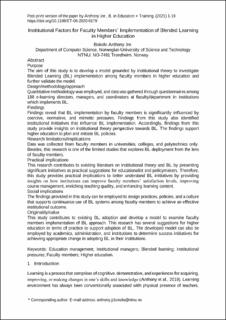| dc.description.abstract | Purpose
The aim of this study is to develop a model grounded by the institutional theory to investigate blended learning (BL) implementation among faculty members in higher education and further validate the model.
Design/methodology/approach
Quantitative methodology was employed, and data were gathered through questionnaires among 188 e-learning directors, managers and coordinators at faculty/department in institutions, which implement BL.
Findings
Findings reveal that BL implementation by faculty members is significantly influenced by coercive, normative and mimetic pressures. Findings from this study also identified institutional initiatives that influence BL implementation. Accordingly, findings from this study provide insights into the institutional theory perspective toward BL. The findings support higher education to plan and initiate BL policies.
Research limitations/implications
Data were collected from faculty members in universities, colleges and polytechnics only. Besides, this research is one of the limited studies that explore BL deployment from the lens of faculty members.
Practical implications
This research contributes to the existing literature on the institutional theory and BL by presenting significant initiatives as practical suggestions for educationalist and policymakers. Therefore, this study provides practical implications to better understand BL initiatives by providing insights into how institutions can improve faculty members' satisfaction levels, improving course management, enriching teaching quality and enhancing learning content.
Social implications
The findings provided in this study can be employed to design practices, policies and a culture that support continuance use of BL systems among faculty members to achieve an effective institutional outcome.
Originality/value
This study contributes to existing BL adoption and develops a model to examine faculty member implementation of BL approach. This research has several suggestions for higher education in terms of practice to support adoption of BL. The developed model can also be employed by academics, administration and institutions to determine success initiatives for achieving an appropriate change in adopting BL in their institutions | en_US |
